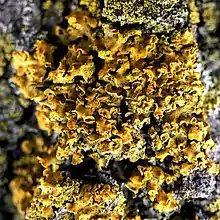| Oxneria fallax | |
|---|---|
 | |
| Scientific classification | |
| Domain: | Eukaryota |
| Kingdom: | Fungi |
| Division: | Ascomycota |
| Class: | Lecanoromycetes |
| Order: | Teloschistales |
| Family: | Teloschistaceae |
| Genus: | Oxneria |
| Species: | O. fallax |
| Binomial name | |
| Oxneria fallax (Arnold) Søchting, Kärnefelt & S.Y. Kondr., 2002 | |
| Synonyms | |
| |
Oxneria fallax, also known as the hooded sunburst lichen, is a small yellow-orange to red-orange foliose lichen that grows on bark or rarely on rock or bone.[1] It is found all over the world except very dry areas, with 10 species common in North America.[1][2]: 130 [3] The nonfruiting body (thallus) grows in rosettes to 3 cm in diameter.[2][3] The rosettes sometimes coalesce with each other.[3] The lobes may appear divided at the tips. It is sometimes tightly appressed to the substrate (adnate), and sometimes not.[2][3] The fruiting bodies (apothecia) are lecanorine, meaning that they are disc-like with a ring or rim of tissue around the disc that is made of tissue similar to the thallus.[2] The tips of the lobes form hood shaped soralia that produce powdery greenish yellow soredia.[2] It prefers growing on elm or oak bark, but can also be found on rocks, bone, or other wood types.[2] Lichen spot tests on the surface are K+ purple, C−, KC−, and P−.[2]
References
- 1 2 Goward, Trevor; McCune, Bruce; Meidinger, Del (1994). Lichens of British Columbia. British Columbia: Ministry of Forests Research Program. pp. 138–140. ISBN 0-7726-2194-2.
- 1 2 3 4 5 6 7 Field Guide to California Lichens, Stephen Sharnoff, Yale University Press, 2014, ISBN 978-0-300-19500-2
- 1 2 3 4 Lichen Flora of the Greater Sonoran Desert Region. Vol 2, Nash, T.H., Ryan, B.D., Gries, C., Bugartz, F., (eds.) 2001,